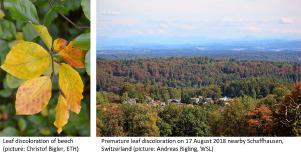Agricultural and Forest Meteorology ( IF 5.6 ) Pub Date : 2021-06-10 , DOI: 10.1016/j.agrformet.2021.108492 Christof Bigler , Yann Vitasse

|
While leaf discoloration of many temperate and boreal tree species has been delayed in response to global warming, climatic stress such as severe drought can cause premature leaf discoloration. We investigated whether leaf discoloration is synchronized within and across tree species and under which climatic conditions premature leaf discoloration occurs (i.e. exceptionally early dates of leaf discoloration within the lower 5 % percentile). We analyzed 16’865 observations of leaf discoloration from nine deciduous tree species (beech, silver birch, horse chestnut, larch, large-leaved linden, rowan, small-leaved lime, sweet chestnut, sycamore) from a phenological network in Switzerland. We considered observations of leaf discoloration from 222 stations that were located between 200 and 1933 m and covered the period 1971–2018. Leaf discoloration of most species has been significantly delayed by 1.5 to 3.3 days per decade from 1996 to 2018. We detected a synchronous temporal pattern of leaf discoloration both within and across species. For most species, premature leaf discoloration occurred in years with very warm and dry spring-summer conditions or with very cool fall temperatures. Premature leaf discoloration was observed in 10-40 % of all stations during these years, whereas the long-term mean was 4-6 %. Growing degree days in May and June were significantly higher and the climatic water balance in June was significantly lower in years with premature leaf discoloration compared to years with regular leaf discoloration, especially for drought sensitive species such as beech. Similarly, minimum temperatures in September were consistently lower in years with premature leaf discoloration. Our study provides the first systematic and long-term assessment under which climatic conditions premature leaf discoloration occurs. We expect that the future increase in the frequency and severity of droughts in Europe will likely increase the risk of premature leaf discoloration.
中文翻译:

欧洲落叶树早叶变色是由晚春的干旱和炎热和初秋的寒潮引起的
虽然许多温带和北方树种的叶子变色因全球变暖而被推迟,但严重干旱等气候压力会导致叶子过早变色。我们调查了叶子变色是否在树种内部和树种之间同步,以及在何种气候条件下会发生过早的叶子变色(即在较低的 5% 百分位内出现异常早期的叶子变色)。我们分析了来自瑞士物候网络的 9 种落叶树种(山毛榉、白桦、七叶树、落叶松、大叶椴树、罗文、小叶酸橙、甜板栗、梧桐树)的 16,865 次叶片变色观察结果。我们考虑了位于 200 到 1933 米之间的 222 个站点的叶片变色观察结果,涵盖了 1971-2018 年期间。从 1996 年到 2018 年,大多数物种的叶片变色每十年显着延迟 1.5 至 3.3 天。我们检测到物种内和物种间叶片变色的同步时间模式。对于大多数物种,在非常温暖和干燥的春夏条件或非常凉爽的秋季温度的年份中发生过早的叶子变色。在这些年中,10-40% 的所有站点观察到过早的叶片变色,而长期平均值为 4-6%。与正常叶片变色的年份相比,叶片过早变色的年份 5 月和 6 月的生长期天数显着增加,6 月份的气候水平衡显着降低,尤其是对干旱敏感的树种,如山毛榉。相似地,9 月的最低温度在叶片过早变色的年份中一直较低。我们的研究提供了第一个系统和长期的评估,在气候条件下发生叶片过早变色。我们预计,未来欧洲干旱频率和严重程度的增加可能会增加叶片过早变色的风险。











































 京公网安备 11010802027423号
京公网安备 11010802027423号